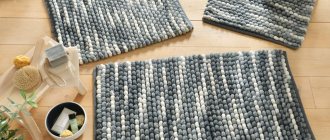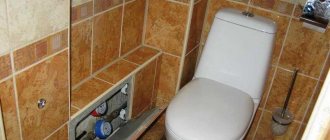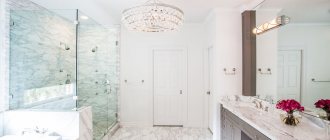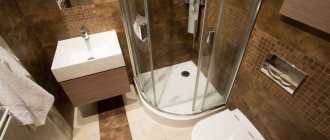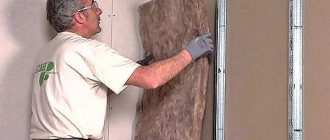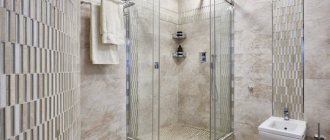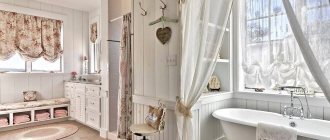Share on social media networks:
The role of the bathroom in a modern apartment cannot be overestimated. In the morning we gain vigor and strength in it, and in the evening we relax, relieve stress and fatigue after a hard day. To fully enjoy the comfort of your bathroom, you need to carefully consider its interior. You can’t do without a good, practical and high-quality cabinet, and a shelf for bathroom accessories wouldn’t hurt. But many apartment owners may have a question about how to hang a cabinet in the bathroom on tiles, because such work requires a special tool, and special fasteners for the cabinet are needed. Today we will tell you how to hang a shelf on the wall in the bathroom so that it is reliable and beautiful.
Basic requirements for bathroom furniture
The bathroom has its own special microclimate, which is different from other rooms. High humidity, sharp temperature changes and lack of space have left their mark on interior items. Bathroom furniture must have the following characteristics:
- High resistance to moisture.
- Endurance to sudden temperature changes.
- Durability of the material.
- Compactness.
Important! Materials such as glass, plastic, metal, MDF, chipboard can be adapted to the conditions of the bathroom, and special types of cabinets will help cope with the lack of space.
Types of bathroom cabinets
The following types of furniture are suitable for a special room:
- Cabinet-pencil case. The rectangular shape and small width of the furniture fit perfectly into the interior of a small room.
- Corner cupboard. To save space in your room, make use of the corner space by installing a corner cabinet there.
- Hanging cabinet. If the floor space is occupied by household appliances (washing machine, plumbing fixtures), then you need to hang the cabinet in the bathroom on the wall in any convenient place.
Important! The hanging cabinet can be either corner or flat (in the form of a pencil case).
- Mirror cabinet. This unique piece of furniture saves space by combining two main pieces of furniture - a mirror and a cabinet. A universal piece of furniture can be a full-height pencil case, a corner or hanging option.
Bathroom furniture can be purchased in a store, ordered in a special workshop, or you can make it yourself. Next, we will tell you how to create a cabinet or shelf yourself.
Arrangement of the hallway and bedroom
The internal design of the wardrobe directly depends on what exactly is planned to be stored in it. This means that when designing a piece of furniture for the hallway, bedroom or living room, you need to clearly know what things will be located there.
Most often, the dimensions of the hallway do not allow for a wardrobe with a depth of more than 40 cm.
Taking into account the fact that about 10 cm is spent on the sliding system, there is very little space left for placing outerwear - jackets, coats, raincoats. And standard hangers simply don’t fit in such a narrow closet. End rods, which are mounted instead of standard ones, will help make the internal structure more functional. They come in both retractable and stationary types. It is unlikely that they will be able to fit the entire outer wardrobe of the family into them, but the basic things can be done.
To store shoes, wire niches are installed where you can place 2-3 pairs of shoes or boots. The rest will have to be stored in boxes. Small pull-out elements will help make the closet convenient, where you can put brushes for shoes and clothes, creams, spare keys, and other small items.
The closet in the hallway is a place where umbrellas, packages, and bags are stored, so you need to take care of the required number of hooks where you can hang everything you need. Using a mirror on the door will not only visually expand the room, but also allow you to see yourself in full size before leaving the house.
A wardrobe for a bedroom is a place to store casual, work clothes, and bed linen. Therefore, before you start making furniture with your own hands, you need to carefully consider all the options for filling it. The most popular are:
- Baskets. They can be made of metal, plastic and are universal for storing things. They can hold both socks and shirts.
- Pantograph. This is a clothes rail equipped with a handle and a mechanism for lowering it down. This option is suitable for those who want to use the upper space as efficiently as possible.
- Iron holder and built-in ironing board.
- Hangers for ties, belts, trousers.
- Drawers for underwear.
- Mounts for storing shoes.
As for built-in wardrobes, many people prefer to make niches for TVs and computers in them. This allows you to unload the room and free up more space.
Cabinet creation process
First of all, choose the material for the future cabinet and take the necessary measurements.
Important! It is best to create a drawing to determine the exact amount of material needed and the method of fastening.
General recommendations:
- With all the abundance of material, wood remains the most popular. We recommend using natural materials for the relaxation room.
- To effectively use every corner of the room, you can make a cabinet for the bath.
- Carry out the work on making the cabinet in a room that is located near the bathroom, so that you can go in at any time and make the necessary adjustments.
Assembly
The process of creating a cabinet is quite simple:
- Make future shelves and walls from the boards.
- Mark the mounting locations for the shelves on the side walls.
- If you plan to add lighting inside, then make holes in the side board to connect the furniture to electricity.
- Fasten all the parts using a furniture corner and self-tapping screws. A more professional connection involves the use of minifix and rafix.
- Install cabinet doors on hinges. We recommend using chrome hinges.
Important! If the design involves mirrored doors, then use more massive hinges for reliability. For mirrored doors, take care of the hinge closers so as not to damage the mirror when closing.
Installing a cabinet in the bathroom
Once the cabinet is assembled, all that remains is to determine how to install it. In the case of a classic pencil case, there should be no difficulties: place it in a predetermined place.
Important! If you have installed legs on furniture, then make sure that they are equipped with adjustment mechanisms. This will help to install the cabinet securely, even if the floor in the room is uneven.
For a wall cabinet, you need to act differently, since you first need to decide on the fastening option. You can hang the cabinet in the bathroom using a mounting strip or using regular furniture hinges.
Attaching the cabinet to the mounting plate
This mounting option will facilitate the cabinet installation process and eliminate minor errors in markings. In addition, it is quite simple and does not take much time and effort.
Important! The disadvantage of this method is the high price of the mounting kit.
The mounting plate kit includes:
- Special rail.
- Hanging hook. The part is attached to the back wall of the furniture and remains unnoticed.
Step-by-step instruction:
- Make markings and mark the places where the cabinet is attached to the wall. Mark the top level of the cabinet on both sides and draw a line.
- From the drawn line, measure down the distance to the canopy hook.
- Draw a second line. This will be the mounting location for the mounting strip.
- Secure the strip with dowels.
- Hang the cabinet and adjust it vertically using awnings.
Fastening with furniture hinges
This method of hanging a bathroom cabinet is cheaper than the previous one, but it will take more time and require an assistant. For fastening, hooks are used that are mounted in the wall and furniture hinges that will be attached to the back wall of the cabinet.
Step-by-step instruction:
- Determine the top boundaries of the cabinet and draw a horizontal line.
- Check the accuracy of the markings using a building level.
- Attach furniture hinges to the back wall of the cabinet.
- Measure the distance to the furniture hinges and mark the indicators on the wall.
- Drill one hole with a hammer drill and attach a hanging hook in it.
- Hang the cabinet from the hook and determine the exact location of the other fasteners.
Important! Remember that you will not have the opportunity to adjust the position of the mount in the future.
- Drill a second hole for the hook.
- Attach a hanging hook and hang the cabinet on furniture hinges.
General rules
Making a wardrobe with your own hands provides many advantages. So, this is not only a significant saving on the family budget, but also an opportunity for imagination and experimentation. In order for the finished product to be comfortable and practical, at the design stage you should be guided by the following tips:
- The number of compartments inside the cabinet must match the number of doors. But this rule does not apply to wide doors, behind which you can install 2 compartments with shelves at once.
- It is convenient to store laundry in cells with a height of 35-40 cm, books - 20-35 cm.
- The optimal opening for long clothes is 150-160 cm, for short ones – up to 100 cm.
- Large items, suitcases, and travel bags are best placed on the top shelf. The height of the opening must be at least 45 cm.
- According to generally accepted standards, the depth of the wardrobe is 60 cm, which is exactly the size of the factory model. If the wardrobe is made independently, it is better to make it at least 65 cm. The fact is that the door mechanism “eats” 10 cm, so only 50 cm remains for clothes with hangers.
- If you plan to install a volumetric handle on the box, then it needs to be recessed a little so that the protruding part does not touch the doors. An excellent alternative to such handles would be the finger grooves on the front panel of the drawer.
- When making drawers with your own hands, it is better to use ball-bearing full extension guides. They are distinguished by their durability, strength and convenience.
- Large cells larger than 80 cm must be reinforced with a partition, otherwise they will bend under the weight of things.
- Rods for clothes longer than 100 cm are also recommended to be additionally reinforced with a vertical rod, the lower end of which rests on the floor, and the upper end on the top shelf. Thanks to this, you don’t have to worry about the heavy weight of your clothes.
- It is better to install the lighting in the cabinet in the remote roof canopy, and not inside the structure, otherwise the light will only fall on the top shelf.
When making a wardrobe with your own hands, we must not forget that the arrangement of things in it must have a certain sequence. For example, on top are placed the most unnecessary things that need to be taken out least often - hats, bags. In the middle are those that are used most often - outerwear. Below are boxes with shoes, bags, backpacks.
How to hang a bathroom shelf on tiles?
If the walls in the bathroom are covered with tiles, then for the work you will need a drill or hammer drill and a special drill for tiles. We will look at the technology of the process using the example of installing a shelf in a bathroom.
Important! Bathroom furniture has different types of fastenings and is made of different materials. Most often, shelves are made of plastic, glass, less often of wood, MDF, chipboard.
Preparation
Before starting the main work, it is necessary to first carry out preparatory activities. Proceed as follows:
- Unpack the shelf to determine mounting options. In some cases, it is easier to mark the holes through the fasteners, and sometimes it makes sense to assemble the shelf and then make precise markings to drill into the wall.
- Find out the material used to make the wall under the tiles. If it is a plaster box or brick, then you can do without a hammer drill, but if it is concrete, a hammer drill is needed.
Tools
Prepare the necessary tools:
- Drill.
- Tile drill. You can use a drill with a pobedit tip.
- Tape measure and level for marking.
- Dowels, screws for fastening. Often they come complete with a shelf.
Important! To hang a shelf in the bathroom without damaging the tiles, follow these simple rules:
- Do not attempt to drill a fastener hole in the tile joints.
- Before drilling the tile, make a small chip so that the drill does not slip, otherwise the hole may turn out to be large.
Step-by-step instruction:
- Mark the drilling location using a tape measure and level. In some cases, you can simply attach the shelf to the wall.
- Make a small chip on the tile with a metal dowel under the drill.
- Turn on the drill and drill through the tile without hitting it. Periodically remove the drill and cool it in water. You can use a spray bottle to cool the drill.
- If there is concrete under the tile, then after you pass the tile, turn on the hammer drill.
- Attach the dowel to the drill and check the depth of the hole. Enlarge the hole if necessary.
- Drive the dowel into the wall using a hammer and screw the screw through the shelf mount.
Important! There are special Irvin tile-concrete drills on sale that do the job perfectly even at low speeds.
Tools required for installation
Below is an instrumental set that you can hardly do without:
- marker;
- roulette;
- drill (+ glass drill and wall drill);
- building level.
First, it is recommended to mark out the bathroom area. This is done using a tape measure, a building level and an ordinary marker. After this, you can proceed to drilling holes.
It is extremely important to use a glass drill bit. But even in this case, we start only at a low speed, gradually increasing. We put almost no pressure on the drill. After the drill hits the wall, you will feel it.
There may be several options for further action. If the walls in the house are brick, everything is extremely simple - insert a drill with a Pobedit tip and go!
If the walls are made of reinforced concrete, you cannot do without a hammer drill. To avoid damaging the tile, it is recommended to drill a hole in the tile itself that is larger in diameter. That is, it is necessary to ensure that the drill on the concrete does not transmit impacts to the tiles. This can only be avoided if the drill does not touch the tile in principle.
Alternative options
In addition to standard methods, you can use other ideas on how to hang a bathroom cabinet on tiles.
Idea 1
If you feel sorry for drilling tiles, then there are alternative options: “liquid nails”, sealant, special suction cups. These options have both their pros and cons:
- Suction cups can be used for small, light, mesh, generally “non-risky” shelves.
- “Liquid nails” are more reliable (1 drop of glue can hold the weight of 50 kg) than sealant, but it is very difficult to remove glue from tiles.
- The suction cup can also be glued with superglue for reliability, but later, if you want to remove the suction cup, it will be quite difficult to scrape off the glue.
Important! To use glue, sealant or suction cups, first degrease the surface of the tile, dry it and warm it up a little. It is advisable to sand the gluing area with a little fine sandpaper.
Idea 2
You can use non-flat hooks for small shelves if you embed them in the seams. Proceed this way:
- Make a workpiece in the shape of the letter T from 1 mm thick stainless steel. The length of the upper “crossbar” and legs should be approximately 25-30 mm, and the width should be 5 mm.
- Insert the bar into the horizontal seam and bend the leg down.
- The seam must first be cleared with a piece of a hacksaw.
- After installing the workpiece, treat the seam with grout.
- After the grout has dried, bend the end upward with a hook.
Important! The advantage of this method: if necessary, the hook can be removed and the seam can be rubbed again, without leaving any traces. Disadvantage: the hook can only support 5 kg.
Choosing material
What should the shelves be made of so that they are strong, durable, and the wardrobe itself lasts a long time? Let's consider the advantages and disadvantages of popular materials:
- Solid wood. The naturalness of this material is beyond doubt; it is excellent when you need to make a shelf durable and rich. A bookcase or dressing room with long shelves, made of wood, will last a long time and will not bend under the weight. Such furniture is famous for its strength and durability. The disadvantage of the solution may be that the finished product weighs too much, as well as the high price compared to budget options.
- Dial array. Unlike solid wood, the price for such niches is much lower, but the benefits are the same. The material consists of blocks of wood glued together and coated with varnish.
- Joiner's board. The material is a frame made of wood, covered with plywood on both sides. Perfect for heavy items, such as books.
- MDF, chipboard. The most common materials available to a wide range of consumers. Used for making shelves in cabinet furniture, suitable for DIY installation. They consist of tiny pieces of wood, pressed and glued together. The standard thickness of the shelves is 16-18 mm, but if you plan to use them to store heavy items, it is recommended to opt for thicker slabs up to 25 mm.
- Glass. This material is used less often than others in the manufacture of shelves in wardrobes. Although it has its advantages: they look light, but are quite durable. Glass can be used to make cells in open areas of the closet in the living room.
- Metal. An excellent solution for making shoe storage racks and baskets from metal rods. You can find the necessary accessories in online stores, and then do the installation yourself.
